Over the years I’ve found some big moths on the property, both as larvae and as adults. When I say big, I mean big enough that people notice them, not the little tiny guys that are present by the hundreds in the grasses and flower beds. I’m talking sphinx moths, family Sphingidae, also known as hawk moths They’re a bit more cryptic, and less spectacular, than their cousins in the family Saturniidae, the silk moths, but they make up for it with the impressive thickness of their bodies (their abdomens) and their ability to hover like a hummingbird (the “hummingbird moth” is a sphinx moth).
They’re large enough, for example, that one of Poe’s characters mistakes one on his windowpane for a truly monstrous beast much farther away (although Poe, with characteristic sleight of hand, reduces the size of the moth in the punch line to this bagatelle, titled simply “The Sphinx,” to 1/16 of an inch, far smaller than they really are).
Here’s a little gallery of these mysterious monsters that have visited my yard.
Mournful Sphinx (Enyo lugubris) back in 2011.
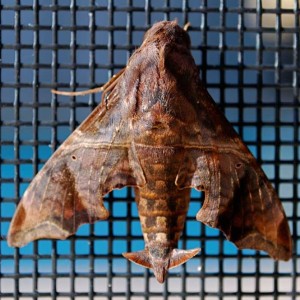
Pluto Sphinx (Xylophanes pluto) back in 2012:
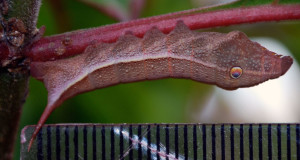
This first caterpillar was pink in color, feeding on the native firebush, Hamelia patens. The images below are either of a later instar or a different individual. They’re nearly 3 weeks later than the picture above, and in addition to being substantially fatter, the caterpillar is brown instead of pink:
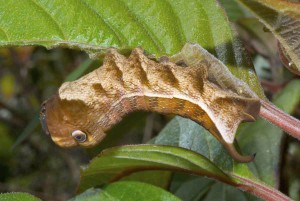
The false eyespots of this species are particularly impressive:

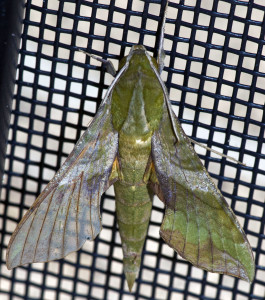
Carolina Sphinx in 2014:
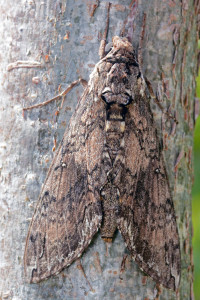
And finally, in 2015, I’ve come across the “default” moth that I’d thought each of those might be in the past: Erinnyis ello, the Ello Sphinx moth. So far, just the caterpillar, but isn’t it a beauty?
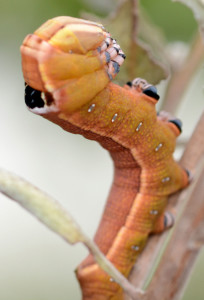

This caterpillar feeds on the leaves of many plants, but in my yard it prefers silver buttonwood (Conocarpus erectus) which, when not being ravaged by herbivorous insects, is a very attractive Florida native. I don’t mind the feeding damage, though, since the caterpillar is so interesting to look at:
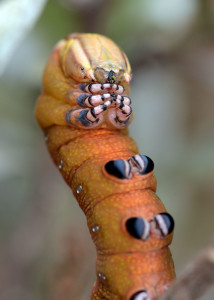
Check out those mouthparts!
There are two on this particular plant, and I speculate that they came from these two eggs:
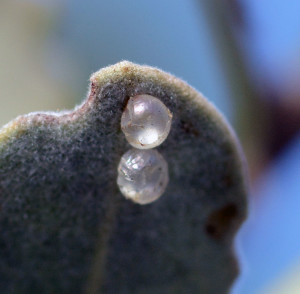
However, there’s no real way to prove that. And after several days of feeding, I’m not entirely sure whether these caterpillars were picked off by the local birds or whether they did manage to pupate and emerge as moths. Whatever the case may be, I never did find the adult moths.
And, sad story but true, I had to remove those buttonwoods this spring. This location was just too dry for this wetland species, so I traded them out for some more xeric plants: saw palmettos. Not to worry, though! In the adjacent side yard, I planted a willow bustic, which is one of the many food plants for the Ello sphinx moth. I’m hopeful that we’ll see more of these little critters soon!

Yesterday (13 Jan ’16) found a small (~24mm ex horn) Erinnyis ello on Dahoon Holly in (where else ?) Hollywood. All of the references I searched had the green or brown versions, not this orange version. Is the “eye” diagnostic regardless of body color?
Yes, that eyespot is pretty distinctive. There aren’t many other caterpillars that it might resemble. And color variation among caterpillars is quite prevalent. I always do my research at bugguide.net; if that site lets me down, then I expand my horizons. Cheers!
I just found a Mournful. Sphinx in my Monarch/Black SwallowTail Safe House. I do not know how he got in or where his It seems kind of stiff..no wing movement…does it fly? Venice Florida
These guys rest for disturbingly long periods. Odds are it’ll fly away, but who knows? (You probably do by now, since your comment is a couple weeks old at this point.)